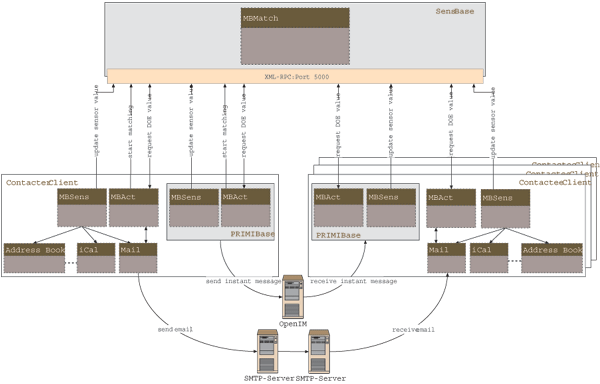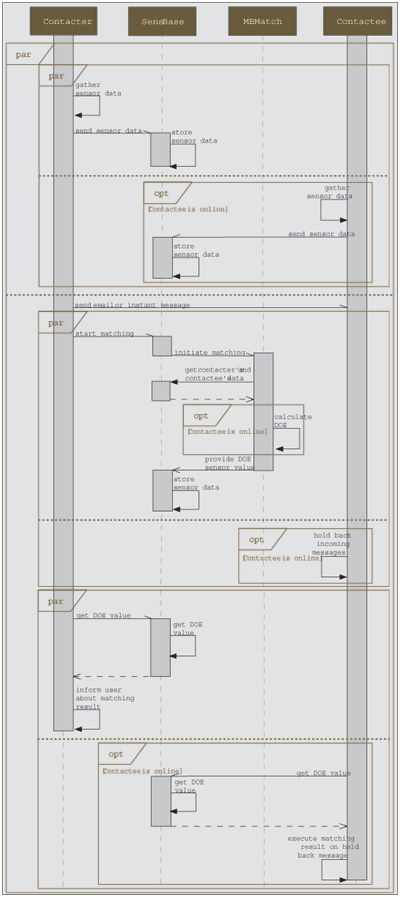|
|
RP_MatchBaseMatchBase - Summer Term 2005DescriptionMatchBase is a development suite for efficient context-aware communication. Context-aware communication aims to mediate communication between contacter (i.e. the person wanting to initiate a conversation) and contactee (i.e. the person who is to be contacted) according to their actual context, where the contacters’ context refers to their current situation and their motivation to initiate the communication and where the contactees’ context refers to their current situation and availability.The MatchBase suite consists of: MBSens—a sensor component with various software and hardware sensors; MBMatch—an inference engine processing the captured information; and MBAct—an actuator component with various actuators that adapt the behaviour of the user’s applications according to the inference results. The MatchBase architecture was developed with the Sens-ation platform and the PRIMI platform. We use the infrastructure of Sens-ation for communication handling and data storage. The PRIMIBase reference implementation is used as instant messenger. The architecture of the MatchBase suite is a client-server-model (cf. Figure 1).  Figure 1. An overview of MatchBase system architecture. The figure shows the MatchBase suite with MBSens, MBMatch and MBAct components and their interaction and communication. System Architecture The client side consists of the MBSens and MBAct components. The MBSens components monitor several applications and continuousely gather data about the user’s context. For the contacter it is essential to dertermine the message’s type, importance, urgency and complexity as well as its matter. On contactee’s side information about his workload and current task are retrieved. As well as obvious indicators, e.g. if he is already in a conversation or in a meeting. A further important factor is the relation between both communication partners. These gathered information are sent via XML-RPC calls to the SensBase server. The MBAct components control several communication applications. When the contacter initiate communication—say sending and email or instant message—the MBAct components react on outgoing messages by notifying the server and MBMatch respectively. The MBMatch component extract all necessary information about the contacter, the contactee and the message from database and matches the preferences of both communication partners to determine the most efficient communication strategy. The matching component is fed with the respective information and calculates a Degree of Effectiveness (DOE). The DOE determines the further behaviour of the system: if the DOE is high, the MBAct actuators on contactee’s side deliver the message immediately; and if the DOE is low the message is held back until the system detects an appropriate time for delivering it. The MBAct actuators on the contacter’s side inform about the results of the message delivery (cf. Figure 2). An overview of the workflow of the system on an occurring interruption situation is shown in Figure 3. Figure 2. Notification windows provide contacter and contactee information about the communication. System Worklflow  Figure 3. Oveview of the system workflow. The figure shows the reaction of SensBase and MBMatch depending on user action. Automatic and User-Driven Context Acquisition Besides the development of the MatchBase suite two different approachs for efficient context-aware communication are studied. Both focus on the anlysis of the contacter’s context and preferences. In the first approach the necessary information are retrieved by a user query (cf. Figure 4).  Figure 4. User query window. The window is displayed to request information about the communication in the user-driven approach when the user has sent a message. The second approach attempts to determine the contacter’s preferences only by sensors. An user evaluation is done for comparison of both approachs. Current StatusSystem evaluation and comparison of the user- and sensor-driven approachResources
PeopleTom Gross (Supervisor)Susanne Krause Simone Braun Created by: oemig last modification: Thursday 21 of July, 2005 [13:09:19 UTC] by oemig |
